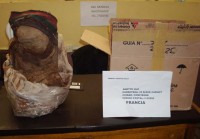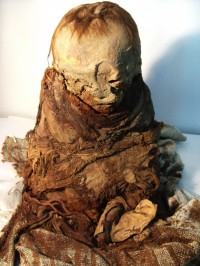 Two years ago, police in El Alto, a suburb of the Bolivian seat of government La Paz, arrested a woman who had been caught during a routine search by postal workers attempting to mail the mummy of a toddler to an address in Compiègne, France. She claimed she had no idea what was inside the package, that she had simply received it in Desaguadero, a small town near the border with Peru, from a man she knew only as Don Gustavo who had instructed her to mail it to France. The mummy was confiscated by the police and then transferred to the Bolivian Ministry of Culture’s Archaeology Unit, which conducted a detailed examination of the artifact.
Two years ago, police in El Alto, a suburb of the Bolivian seat of government La Paz, arrested a woman who had been caught during a routine search by postal workers attempting to mail the mummy of a toddler to an address in Compiègne, France. She claimed she had no idea what was inside the package, that she had simply received it in Desaguadero, a small town near the border with Peru, from a man she knew only as Don Gustavo who had instructed her to mail it to France. The mummy was confiscated by the police and then transferred to the Bolivian Ministry of Culture’s Archaeology Unit, which conducted a detailed examination of the artifact.
Investigations since then haven’t contradicted her story, but not many specifics have been uncovered. There’s little doubt the mummy was destined to be sold in France. Smugglers had replaced the missing left leg with the mummified leg of a younger child and added three textiles to the two original cotton and cameloid wool pieces in order to complete the mummy so it would sell for a higher price. The textiles identified the mummy as Peruvian rather than Bolivian (Bolivian mummies were wrapped in straw). Archaeologists believe it dates to the pre-Inca Late Intermediate period (1000 A.D.-1450 A.D.), possibly from one of the southern coastal cultures like the Chiribaya or Paracas.
 In keeping with the Convention for the Recuperation of Cultural Goods and Others Stolen, Imported or Exported Illicitly, a bilateral agreement signed by Bolivia and Peru in 1998 and ratified in 2000, the little mummy was officially returned to Peru in a ceremony at the Peruvian Foreign Ministry in Lima on Tuesday, November 6th. This is the first time Bolivia has repatriated human remains to the country from which they were looted. Peru didn’t add skeletal and mummified human remains to its “red list” of cultural heritage goods endangered by illegal export until 2009. Until recently, most of the looted and trafficked artifacts from Peru were textiles, ceramics, jewels, precious metals and stones. There’s been a notable increase in the trafficking of human remains since the financial crisis, sadly.
In keeping with the Convention for the Recuperation of Cultural Goods and Others Stolen, Imported or Exported Illicitly, a bilateral agreement signed by Bolivia and Peru in 1998 and ratified in 2000, the little mummy was officially returned to Peru in a ceremony at the Peruvian Foreign Ministry in Lima on Tuesday, November 6th. This is the first time Bolivia has repatriated human remains to the country from which they were looted. Peru didn’t add skeletal and mummified human remains to its “red list” of cultural heritage goods endangered by illegal export until 2009. Until recently, most of the looted and trafficked artifacts from Peru were textiles, ceramics, jewels, precious metals and stones. There’s been a notable increase in the trafficking of human remains since the financial crisis, sadly.
The repatriation of the toddler mummy, in addition to being a function of the pre-existing bilateral agreement, was also the symbol of a new pact signed at Tuesday’s ceremony. In recognition of their shared Andean culture, Bolivia and Peru have agreed to a plan of action to combat the trafficking of cultural patrimony that will engage not just both governments but also private companies in the recovery of looted artifacts. The document was signed by Peruvian Minister of Culture Luis Peirano and Bolivian Culture Minister Pablo Groux. It is their hope that this plan will help fight trafficking between the bordering nations and serve as a signal to other countries to respect their cultural heritage.
Peruvian Foreign Minister Rafael Roncagliolo spoke during the ceremony, saying that the new agreement will improve procedures and techniques used to combat the trade in illegal artifacts. They won’t be relying only on police work, but principally creating a program of academic and archaeological cooperation between Bolivia and Peru that will be vital to the formulation of a common strategy of heritage protection. Since, like the traffic in drugs and weapons, cultural property trafficking is large-scale organized crime that has elaborate networks in many countries at once, in order for one country to combat it, it must work closely together with other countries. These agreements can pave the way to allow for the repatriation of cultural artifacts with a minimum of complex, time-consuming and expensive bureaucracy.
The traffic in Peruvian artifacts is endemic throughout Latin America.
An archaeologist at Argentina’s National Institute of Anthropology and Latin American Thought, Julio Avalos, said he and his colleagues are frequently called by police to assess whether relics encountered at airports and Buenos Aires’ seaport — or for sale on the Internet — are protected patrimony.
“Most of it is Peruvian because that’s what there is mostly,” Avalos said.
Just last year three skulls and a mummy from the pre-Incan Paracas culture (7th c. B.C.-3rd c. A.D.) of coastal Peru were intercepted by customs agents in Argentina. They had been sent in the mail from (you guessed it) Bolivia to an Argentine citizen in Buenos Aires and were spotted when the package, labeled as containing replica Peruvian ceramics, was X-rayed in the post office. The recipient was detained on smuggling charges, but officials believe the ultimate destination for the trafficked human remains was yet again the European antiquities market.